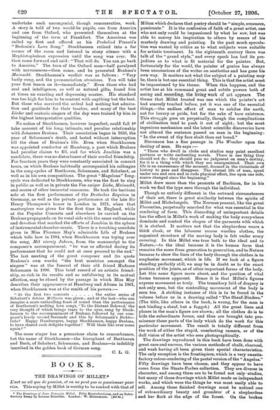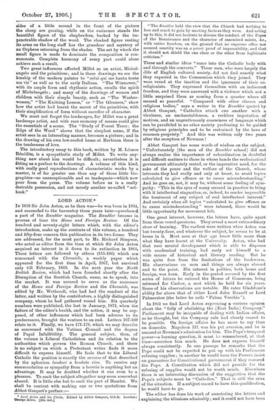BOOKS.
• THE DRAWINGS OF MILLET.* L'art ne wit que de passion, et on ne pent pas se passionner pour rien. This saying by Millet is worthy to be ranked with that of • The Drawings of Jean Francois Millet. Fifty Reproductions, and an Intro- ductory Essay by Leonce BOnedite. London : W. Heinemann. [O14 es.]
Milton which declares that poetry should be "simple, sensuous,
passionate." It is the confession of faith of a great artist, one who not only could be impassioned by what he saw, but was able to convey his inspiration to others by means of his masterly drawing and painting. In the past much specula- tion was wasted by critics as to what subjects were suitable for artistic treatment. In the eighteenth century there was talk of the " grand style," and every epoch has had its pre- judices as to what is fit material for the painter. But, fortunately for the world, the painter of genius has always been unconscious of the writer on aesthetics and has gone his own way. It matters not what the subject of a painting may be, there is but one essential thing. This is that the artist must be impassioned by his theme. When this happens, and the artist has at his command great and subtle powers both of seeing and recording, the living work of art appears. The theme that Millet treated was one which the painter's art had scarcely touched before, yet it was one of the essential things,—the endless effort of man to subdue the earth, not for luxury or pride, but for the sake of bare existence. This struggle goes on perpetually, though the complications of civilisation tend to push it out of sight ; but the most ingenious mechanism and the latest scientific discoveries have
not altered the sentence passed on man in the beginning: " In the sweat of thy face shalt thou eat bread."
Stevenson has a fine passage in The Wrecker upon the destiny of man. He says :— " Those who dwell in clubs and studios may paint excellent pictures or write enchanting novels. There is one thing they should not do : they should pass no judgment on man's destiny, for it is a thing with which they are unacquainted. Their own life is an excrescence of the moment, doomed in the vicissitude of history to pass and disappear. The eternal life of man, spent under sun and rain and in rude physical effort, lies upon one side, scarce changed since the beginning."
Millet drew more than the peasants of Barbizon, for in his work we find the type seen through the individuaL
Though so entirely different in the outward circumstances of their art, there is great similarity between the spirits of Millet and Michelangelo. The Norman peasant, like the great Florentine, perpetually searched for what was essential in the rendering of form. This discarding of unimportant details has the effect in Millet's work of making the body everywhere dominate and control the shapes of the garments with which it is clothed. It matters not that the shepherdess wears a thick cloak, or the labourer coarse woollen clothes, the organised structure of the moving body is felt under every covering. In this Millet was true both to the ideal and to Nature,—to the ideal because it is the human form that remains the same from generation to generation, and to Nature because to show the lines of the body through the clothes is to emphasise movement, which is life. If we look at a figure
standing perfectly still, we may be in doubt as to the exact position of the joints, as of other important forms of the body.
Let this same figure move about, and the position of vital forms becomes apparent. Hence it is that Millet's figures express movement so truly. The transitory fold of drapery is not only seen, but the controlling movement of the body is seen too. A striking instance of this is to be found in the volume before us in a drawing called " The Sheaf-Binders." (The title, like others in the book, is wrong, for the man is not binding a sheaf, but a faggot.) All the great lines and planes in the man's figure are shown; all the clothes do is to hide the subordinate forms, and thus are brought into pro- minence those parts of the body which do the work for this particular movement. The result is totally different from the work of either the stupid, unselecting camera, or of the dull vision of the artist who sees photographically.
The drawings reproduced in this book have been done with great care and success, the various methods of chalk, charcoal, and wash having all been given their special characteristics. The only exception is the frontispiece, which is a very unsatis- factory colour-rendering of the pastel version of the "Angelus." Fifty drawings have been chosen, and they appear to have come from the Staats-Forbes collection. They are diverse in character, and among them are to be found not only- studies, but many of those drawings which Millet made as independent works, and which were the things he was most easily able to sell. Among these finished drawings must be noticed one of extraordinary beauty and grandeur of a shepherdess and her flock at the edge of the forest. On the broken
sides of a. little mound in the front of the picture the sheep are grazing, while on the eminence stands the beautiful figure of the shepherdess, backed by the im- penetrable shadow of the wood. The cloaked. figure resting its arms on the long staff has the grandeur and mystery of an Orpheus returning from the shades. The art by which the small figure is made to dominate the composition is con- summate. Complete harmony of every part could alone achieve such a result.
TWo great influences affected Millet as an artist, Michel- angelo and the primitives; and in these drawings we see the kinship of the modern painter to " celui qui me hanta touts ma vie" as well as to the early Italians. "The Winnower," with its ample form and rhythmic action, recalls the spirit of Michelangelo ; and many of the drawings of women and Children with their simple beauty, such as " The Washer- women," " The Knitting Lesson," or " The Gleaners," show how the artist had learnt the secret of the primitives, with their simplification of form without sacrifice of character.
We must not forget the landscapes, for Millet was a great landscape artist, and with rare economy of means could give the essentials of a scene. The "Study of Forest Trees : the Edge of the Wood " shows that the simplest scene, if the artist sees in an interesting manner, becomes a picture; and in the drawing of his own low-roofed home at Barbizon there is the tenderness of love.
The introductory essay to this book, written by M. Monce Benedite, is a sympathetic study of Millet. To write any- thing new about him would be difficult; nevertheless it is fitting as a preface to the drawings. A volume of this kind, with really good reproductions of characteristic works by a master, is of far greater use than any of those little bio- graphiesso unexceptionable and so inadequate—which now pour from the press. The volume before us is a really desirable possession, and not merely another so-called " art- book."















































 Previous page
Previous page